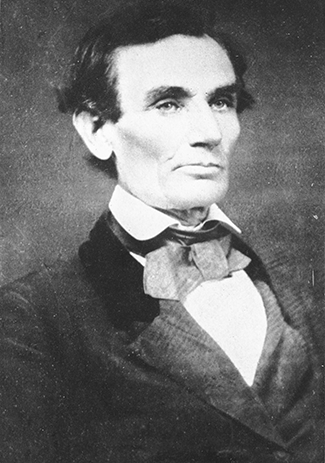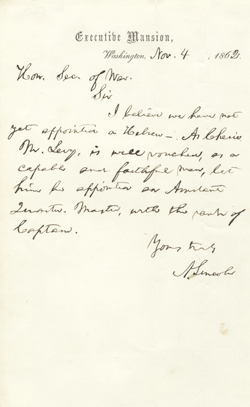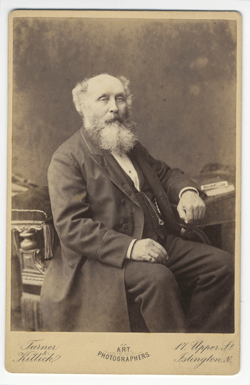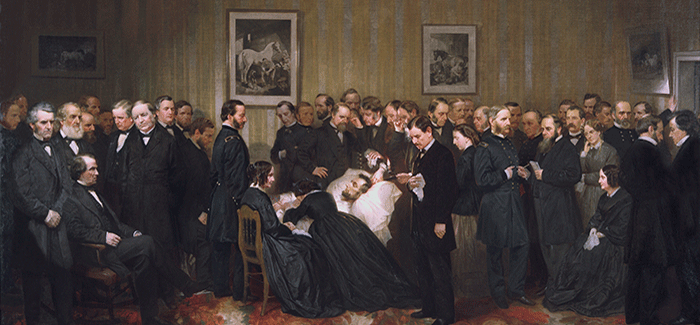Arts
Exhibit
The Second Abraham

On November 4, 1862, President Abraham Lincoln penned a brief letter on official letterhead (“Executive Mansion, Washington”) to Secretary of War Edwin Stanton. “I believe we have not yet appointed a Hebrew,” he writes in his flowing cursive, and selects C.M. Levy, a practicing Jew from New York and a “capable and faithful man,” as assistant quartermaster responsible for Army housing, transportation, clothing and supplies.
In a few lines, Lincoln redresses what he perceived as an inequality at a time when anti-Semitism was rife in America.
The letter is one of the highlights of “Lincoln and the Jews,” an exhibit that premiered at the New-York Historical Society and is currently at the Abraham Lincoln Presidential Library and Museum in Springfield, Illinois, through November 5. Marking the 150th anniversary of Lincoln’s assassination and the end of the Civil War, the exhibition examines the intersection of Civil War history, Lincoln’s political ascent and the rise of the nascent Jewish community. Subtitled “With Firmness in the Right,” a phrase from Lincoln’s Second Inaugural address (“With malice toward none, with charity for all, with firmness in the right as God gives us to see the right…), the show emphasizes Lincoln’s unwavering commitment to equality and tolerance and depicts the reciprocally supportive relationships between Lincoln and the Jewish community.
More than 80 documents reveal Lincoln’s surprising Jewish connections: letters, official appointments, pardons, proclamations, personal notes and autobiographical accounts, supplemented by photographs and paintings, artifacts and interactive media. One of the most powerful artifacts is a painted American flag that Abraham Kohn, a Chicago clothier and Jewish community leader, bestowed on Lincoln just before his first inauguration. On the white stripes, a Hebrew inscription from the Book of Joshua reads, “Be strong and of a good courage…. Be not afraid, neither be thou dismayed; for the Lord thy God is with thee whithersoever thou goest.”
The show is inspired by the publication of Lincoln and the Jews: A History (Thomas Dunne Books) by historian Jonathan D. Sarna and Benjamin Shapell, founder of The Shapell Manuscript Foundation, an organization that collects original manuscripts and historical documents from the United States and Israel (see column by Sarna, page 40). “When presiding over this brutal Civil War, Lincoln found time to help Jews and Jewish causes,” says Shapell, who bought his first Lincoln letter in 1979. “I wanted viewers to become familiar with never-before-seen physical examples of the depth and breadth of this unique relationship.”

The documents do not disappoint. Their groundbreaking legal content is reflected in two major issues: Lincoln’s amendment of a longstanding law that prohibited Jews and other non-Christians to serve as chaplains, and his revocation of General Ulysses S. Grant’s notorious order expelling “Jews as a class” from the territory then under Grant’s command. But there is the draw of something much more basic, mirrored in Lincoln’s elegant signature—A. Lincoln, with the A looped through the L. Sometimes, words are crossed out; the ink is blotchy; the paper, stained and aging, reveals its folds, all deepening the experience.
“In an age when material of great quality is easily available on the Web, you get a certain buzz when you see the actual things people touched, when you are in the presence of the documents Lincoln wrote,” notes Harold Holzer, author of 50 books on Lincoln and the exhibit’s chief historical advisor.
The show opens with a graphic of a large wheel: A young, clean-shaven Lincoln is in the middle, surrounded by concentric circles encompassing his close friends, associates and supporters, acquaintances, appointments and pardons. “Lincoln was personally broadened by these encounters and as a result, he broadened America,” the wall text reads.
“There is no suggestion that Lincoln spent time calculating the political results of his interaction with the Jewish community,” says Holzer. “His major emphasis was on slavery, but the fact that he gave the Jewish community any thought at all was a sign of the consistent compassion he brought to everything.”
One of the keys to Lincoln’s principled determination was the centrality of the Bible in his life. He frequently used biblical citations, alluded to biblical stories and reflected on God’s purpose. Raised in a Calvinist family, the Hebrew Bible served as a moral compass and a source of comfort for the self-taught Lincoln, who did not belong to any religious denomination as an adult. The exhibit features a photograph Lincoln signed to Lucy Speed, the mother of a childhood friend, in thanks for the Oxford Bible she gave him 20 years earlier, after he broke his engagement to Mary Todd (whom he later married).
Lincoln’s image was crafted by a Jew. When Lincoln was brought to Samuel Alschuler’s studio in Urbana, Illinois, to have his portrait taken in 1858, the Bavarian-born photographer lent Lincoln his own velvet-collared jacket to replace Lincoln’s stained linen coat. Two years later, Alschuler took the first portrait of Lincoln with a beard: It transformed Lincoln from a lean-faced rail-splitter to an avuncular statesman, says Holzer. The two photographs are highlighted in a tripod-shaped case.

The portrait of Lincoln that emerges from the exhibit transcends the posed image. His integrity shines through in his letters, side by side with his love of wordplay and sense of humor. Shapell singles out a letter Lincoln wrote to William Kelley, a Philadelphia congressman, on the cusp of winning the presidency in 1860. “He gives a timeless lesson in humility: While agreeing to have a forthcoming legal book dedicated to him, he…requests ‘that the inscription may be in modest terms, not representing me as a man of great learning, or as a very extraordinary one in any respect.’”
The Jewish community in America was burgeoning and moving toward the Midwest. Yet even with an influx of German immigrants, when the Jewish population jumped from 3,000 to 150,000, it was just a half of one percent of the total population in 1850. Few Americans had direct interaction with Jews, and derogatory stereotypes abounded, as represented in a caricature of a Jewish peddler, on display. The show depicts two Jewish communities through photographic panoramas and maps of their streets and Jewish sites: Cincinnati, just miles from Lincoln’s birthplace, and Richmond, Virginia, which became the Confederate capital and whose fall ended the Civil War.
In Cincinnati, Lincoln met Abraham Jonas, an English-born peddler-turned-lawyer who housed his law practice below the synagogue he started with his brother Joseph. The two Abrahams traveled the law circuit together; they were kindred spirits and political allies who worked fervently for abolition and for the advancement of the Republican Party. A portrait of Jonas in a plaid vest and coat hangs near a note Lincoln wrote to him in 1856 from court. Lincoln was defending his stepbrother’s crippled son, who had been accused of stealing: “I am here at court and find myself so ‘hobbled’ with a particular case that I can not leave.” The embarrassing family situation that Lincoln alludes to through a shorthand pun with a double entendre did not need further explanation between the close friends.
“For some people the question of having Jewish friends may seem trivial,” says Sarna, “but social scientists reveal what we know intuitively. When we have friends who are members of a persecuted group we look at that group differently. You don’t listen to folks who make broad unsavory accusations because you say, ‘my friend is not like that.’”
Jonas, who later moved to Quincy, Illinois, and became a member of the state legislature, encouraged Lincoln to run for a Senate seat in 1855. “I should prefer you to any other and should be pleased to render you any service in my power,” Jonas writes. Lincoln lost, but ran for Senate again in 1858, famously opposing Stephen Douglas on the issue of slavery in a series of seven debates that Jonas helped organize. He lost again, but Jonas urged him to run for president, and helped him to obtain the 1860 nomination at the Republican National Convention in Chicago.
Lithographs and illustrations of Lincoln on the campaign trail are placed next to his famous speeches: “A house divided” (Springfield, 1858); “I think slavery is wrong morally and politically” (Cincinnati, 1859); “Let us have faith that right makes might and in that faith let us in the end dare to do our duty as we understand it” (New York, 1860).

Jonas requested a copy of the Lincoln-Douglas debates, which were collected and bound. In his reply, Lincoln acknowledged Jonas as “one of my valued friends,” a description he did not bestow on anyone else, and later sent him the book, which is on display. Their alliance went beyond politics: Jonas saved Lincoln’s life. In a densely worded letter marked “Private,” Jonas warns of an assassination plot before Lincoln’s first inauguration; he had heard of the rumors from his extended family in New Orleans. “Large numbers of despicable characters…will be in Washington on the 4th of March and it is their determination, to prevent the inauguration…by using violence on the person of Lincoln.”
Lincoln was able to change trains in darkness and arrive safely. He later reciprocated Jonas’s kindness by giving him a plum patronage job as postmaster of Quincy—
a job Lincoln had once held himself. After Jonas died in 1864, Lincoln awarded the position to his widow, Louisa—an unusual move both because she was a woman and because he had turned down his own cousin’s request for a similar job. Visitors can read the appointment letters.
The story of the Jonas family also represents the largely untold story of Jews in the Civil War. “It’s a house as divided as the rest of country, yet there is sacrifice and participation on a scale not completely acknowledged and understood,” says Holzer. Though 7,000 Jews later served in the Union army, the majority of Jews did not support Lincoln’s candidacy because of fear of war, threat of commercial loss or outright support of slavery.
Families like the Jonases, with branches in the North and South, were separated by geography and allegiance. A wall illustration of the family shows their staunch Confederate support. Only one of Jonas’s six sons was loyal to the Union (though another later switched his allegiance to the Union). Yet another Jonas son, Charles, who was imprisoned in a Union jail, received a three-week parole pass from Lincoln to visit his father on his deathbed and attend the funeral.
Snippets from the lives of Jewish soldiers are interspersed in the Lincoln story. A pocket mezuza and travel candlesticks demonstrate a commitment to keeping their faith. The inscribed handle of dueling pistols presented to the Civil War hero Edward S. Salomon declares him to be “the most popular soldier of Cook County, Illinois,” 1867. A group of 20 soldiers was able to obtain matza and prayerbooks, but used a bitter weed for maror, cider for the four cups and “a brick to look at” for haroset.
Lincoln’s other major Jewish friendship was with his enigmatic chiropodist (podiatrist), spy and confidant Issachar Zacharie, whose photograph shows him to be balding and white-bearded. A poster Zacharie signed proclaims: “Soldiers, Attention! All soldiers having corns, bunions or bad nails upon their feet can have them CURED without pain…under the authority of the Secretary of War.” Lincoln’s own testimonial is both humorous and telling: “My chiropodist is a Jew and he has so many times ‘put me on my feet’ that I would have no objection to giving his countrymen ‘a leg up.’”
Lincoln entrusted Zacharie with several secret missions, even sending him to New Orleans to promote pro-Union sentiments among his Jewish “countrymen.” Zacharie also worked to win Jewish voters to Lincoln’s side in the 1864 election. In return, Lincoln instructed Secretary of War Stanton to grant passage for Zacharie to visit his family in Savannah. The letter is bluntly titled, “About Jews.”
The issues of chaplaincy and Grant’s General Order No. 11 tested Lincoln beyond his friendships. The chaplaincy law stated that chaplains had to be ordained by a Christian denomination. The efforts of Jewish regiments to appoint their own chaplains were rejected, until Lincoln appointed Jacob Frankel of Philadelphia the first Jewish chaplain in September 1862. The elaborate document, stamped with a green seal, is decorated with an eagle on top and a collage of cannons, arrows and flags at the bottom.
A military telegraph details Grant’s ban on Jews from the vast area under his command, “the most notorious act of official anti-Semitism in American history,” according to the wall text. Jews were stereotyped as greedy moneygrubbers and blamed for the smuggling of cotton across enemy lines, which caused the price to soar. Lincoln rescinded the order. In the Israelite newspaper, Rabbi Isaac Wise quoted Lincoln as saying: “I do not like to hear a class or nationality condemned on account of a few sinners.” Grant later admitted that he had made an error.
The exhibit ends with a section on Lincoln’s last days. The centerpiece is a large painting by Frederic Church, Jerusalem from the Mount of Olives, accompanied by a letter from Mary Todd Lincoln to her pastor a year after the death of her husband, stating that he had expressed a wish to visit Palestine. On the next wall, a reproduction of Alonzo Chappel’s painting of Lincoln on his deathbed shows him surrounded by a crowd that includes Dr. Charles Liebermann, a renowned Jewish eye surgeon. A blood-stained manuscript by Dr. Robert Stone, the Lincolns’ family physician, describes the president’s last hours.
Lincoln died on a Saturday in the middle of Passover. Many Jews were in synagogue when his death was announced—and many of the first eulogies were Jewish ones. “We should regard Abraham Lincoln…as a son of Israel,” wrote Rabbi Benjamin Szold of Baltimore, the father of Henrietta Szold, Hadassah’s founder. “And if…he was not flesh of our flesh or bone of our bone, he was indeed spirit of our spirit and soul of our soul.”
Rahel Musleah’s website is www.rahelsjewishindia.com.










 Facebook
Facebook Instagram
Instagram Twitter
Twitter
Karl Burkhalter says
Judah Benjamin is far more representative of US Jewish sentiment during the War. Most Jews saw through the duplicity of Invasion. They saw a North that wanted to be free of Blacks not free for Blacks. Hurlbut’s deportation of Jews from Memphis is typical of WASP bias. This Lincoln Worship is blasphemy.